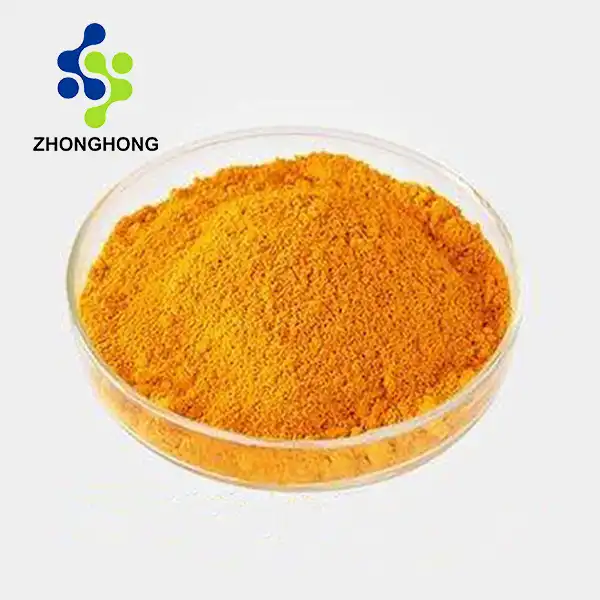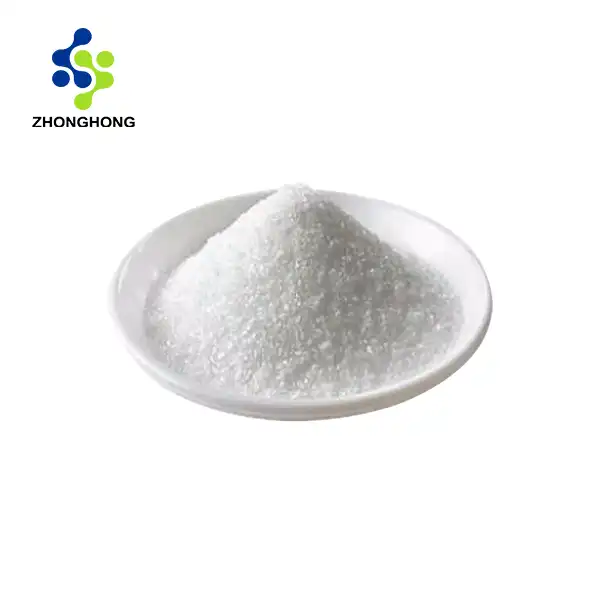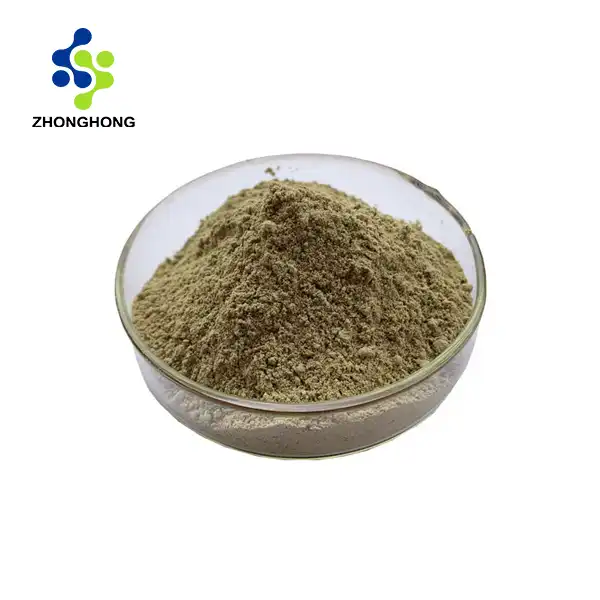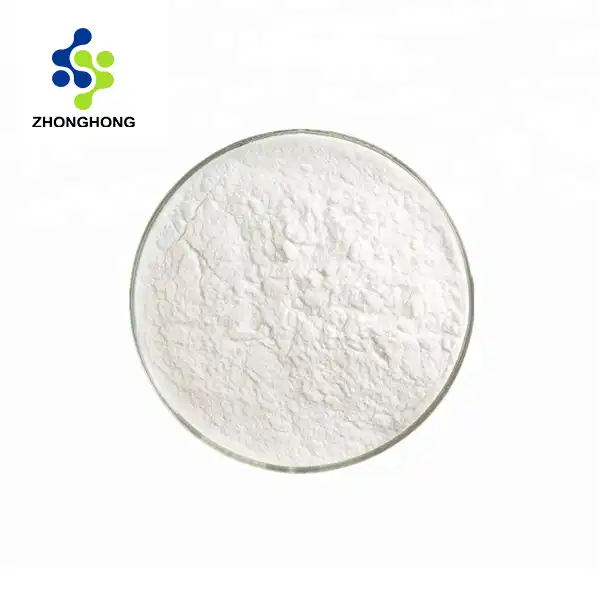pharmacological action
1. Gallbladder: This product or its sodium salt has a choleretic effect. When injected intravenously, it can reduce the content of solid components in dogs and increase bile secretion. But throughout its entire bile secretion cycle, the absolute total excretion of bile salts, bilirubin, and cholesterol increases, while the fatty acid composition remains constant.
2. Antibacterial: It has a strong antibacterial effect on Staphylococcus aureus.
Oral administration of 5-20mg/kg can inhibit gastric damage in guinea pigs caused by intramuscular injection of 20mg/kg 5-hydroxytryptamine. It has a protective effect on liver damage caused by acetaminophen.
1. Introduction
In the vibrant world of natural health and biotechnology, Shaanxi Zhonghongtou Technology Co., Ltd. shines as a leading force. Specializing in the extraction and utilization of bioactive substances, we are committed to providing innovative and high-quality plant-based products. One of our standout offerings is Curcumin Extract, renowned for its powerful properties and diverse applications. This article delves into the details of this remarkable product, our company's strengths, and why it's a top choice for health and wellness solutions.
2. Company Edge
Academic Alliances: Partnering with 5 prestigious universities, we've established joint laboratories. This synergy enables us to access cutting-edge research, ensuring our products are at the vanguard of scientific innovation.
Patent Prowess: Armed with over 20 patented technologies and a unique global compound library, we've developed proprietary extraction and purification methods. These give our curcumin extract an edge in terms of potency and quality.
Sophisticated Equipment: Our state-of-the-art facility houses international leading detection systems like high-performance liquid chromatography and superconducting nuclear magnetic resonance spectrometers. This allows us to maintain a purity standard that outpaces the industry by 20%, guaranteeing superior products.
Global Footprint: With a network spanning 30+ countries across Asia, Europe, and the Americas, we offer bespoke raw material solutions to multinational pharmaceutical firms and research institutions.
3. Curcumin Extract Unveiled
Source: Derived from the rhizomes of turmeric (Curcuma longa), a plant native to South Asia. We source from regions with optimal growing conditions to ensure the richest curcumin content.
Chemical Properties: Curcumin has a chemical formula of C₂₁H₂₀O₆. It belongs to the polyphenol family and is responsible for turmeric's vibrant yellow color. Its unique molecular structure endows it with antioxidant, anti-inflammatory, and other beneficial properties.
Description: Presented as a fine, bright yellow-orange powder. Our advanced extraction processes ensure a high concentration of curcuminoids, making it a potent ingredient in various formulations.
4. Health Benefits Galore
Powerful Antioxidant: It scavenges free radicals, protecting cells from oxidative damage linked to aging, cancer, and chronic diseases.
Anti-Inflammatory Might: Reduces inflammation by inhibiting key inflammatory pathways, beneficial for joint pain, arthritis, and inflammatory bowel diseases.
Brain Health Booster: May enhance cognitive function, potentially delaying neurodegenerative diseases like Alzheimer's. It improves blood flow to the brain and reduces oxidative stress there.
Heart Health Ally: Helps lower cholesterol levels, reduces blood pressure, and prevents blood clot formation, safeguarding cardiovascular health.
Cancer Prevention Potential: Some studies suggest it can interfere with cancer cell growth and metastasis, though more research is needed.
5. Usage Guidelines
Dosage: For general health maintenance, 500 - 1000 mg daily (capsules/powder) is recommended. Higher doses under medical supervision may be used for specific therapeutic purposes.
Form: Available in capsules, tablets, water-soluble powders, and even as an ingredient in functional foods and beverages.
Administration: Take with meals to boost absorption. Avoid if allergic to turmeric. Pregnant or breastfeeding women and those on certain medications should consult a doctor first.
6. Product Specifications
| Parameter | Standard | Testing Method |
|---|---|---|
| Appearance | Bright yellow-orange powder | Visual inspection |
| Curcuminoids Content | ≥95% (HPLC-verified) | HPLC-MS/MS |
| Heavy Metals | ≤0.5 ppm (Pb, As, Cd) | ICP-MS |
| Pesticide Residues | ≤0.1 ppm total | GC-MS |
| Moisture | ≤5% | Karl Fischer Titration |
7. Production Process
Sourcing: Premium turmeric rhizomes are carefully selected from sustainable farms.
Extraction: Employ a combination of supercritical CO₂ extraction and solvent extraction under controlled conditions to extract curcuminoids.
Purification: Use chromatography and membrane filtration to remove impurities and obtain high-purity curcumin.
Drying: Spray-dried or vacuum-dried to preserve bioactivity and ensure a stable powder form.
8. Applications Abound
Health Supplements: A staple in antioxidant, anti-inflammatory, and immune-boosting formulas.
Cosmetics: Used in anti-aging creams, sunscreens, and skin brightening products due to its antioxidant and skin-soothing properties.
Pharmaceuticals: Investigated for potential use in treating various diseases, from arthritis to cancer.
Functional Foods: Added to teas, juices, and snacks to enhance their nutritional value.
9. Quality Assurance
Certifications: ISO 9001, GMP, and other relevant certifications underpin our commitment to quality.
Testing: Stringent in-house and third-party tests at every production stage ensure purity, potency, and safety.
10. Packaging & Logistics
Options: Versatile packaging such as 1 kg foil bags, 25 kg drums, or custom OEM packaging to suit different customer needs.
Shipping: Global air/sea freight with temperature control to maintain product integrity. Free samples available on request.
11. Customer Support
Samples: Request free samples to assess quality and efficacy.
Technical Data: Receive Certificate of Analysis (COA), Material Safety Data Sheets (MSDS), and batch reports for transparency.
Contact: Email [liaodaohai@gmail.com] for bulk orders or partnerships.
12. FAQ
Q: Is Curcumin Extract safe for long-term use?
A: Generally, when taken within recommended doses, it's considered safe. However, consult a healthcare provider for long-term use.
Q: Can it interact with medications?
A: It may interact with blood thinners, diabetes medications, and some chemotherapy drugs. Always inform your doctor.
13. References
[1] Journal of Agricultural and Food Chemistry. (20XX). "Bioactive Properties of Curcumin: A Review."
[2] Journal of Neuroscience Research. (20XX). "Curcumin and Brain Health: Current Evidence and Future Perspectives."
[3] European Journal of Pharmacology. (20XX). "Anti-inflammatory and Anti-cancer Activities of Curcumin."
14. Conclusion
Curcumin Extract from Shaanxi Zhonghongtou Technology Co., Ltd. offers a natural, science-backed pathway to enhanced health and well-being. Leveraging our technological prowess, global reach, and dedication to quality, we provide a premium product trusted by industries worldwide.
Disclaimer: This content is for informational purposes only. Always consult a healthcare provider before use.
Meta Description: Discover the benefits of Curcumin Extract for health, beauty, and more. High-quality extracts from Shaanxi Zhonghongtou Technology with advanced R&D and global service. Contact for bulk orders!
_1728976869676.webp)











